Learning from Riverfront North
Riverfront North is teeming with life. Here we’ll take a deeper look at the science behind the flora and fauna along the living shoreline. Below you’ll find some of the scientific topics we’ve delved into. Keep checking back for new topics. There’s a lot to learn!
Forest Restoration
What does ‘forest restoration’ mean?
Riverfront North Partnership is excited to be embarking on a forest restoration project in the north woods of Pennypack on the Delaware Park.
Out with the old, in with the new
In a nutshell – we are removing old, dying, invasive trees and replacing them with new trees, native to the region. Why? The old White Mulberry trees in this section of the park are reaching the end of their life span and are falling down, creating a dangerous environment for park users. They are also preventing the sun and rain resources from reaching native trees and other plant species, restricting growth that would enrich the park ecosystem.
For the people and for the animals!
By clearing out the old trees, we are creating a safer park for the community and a more sustainable environment for animals that depend on the park to survive. The park is home to a pair of nesting bald eagles, beavers, fox and more. The fish in the river also continue to benefit from the water quality improvements from the forest restorations.

Diversity!
This restoration project will take the Pennypack forest tree biodiversity from about 10 species to over 40 different species – that’s quadruple the diversity in just a year! That is not even accounting for the dozens of new species of shrubs and herbaceous plants that have been introduced because of the restoration process. These plantings provide extra food and shelter for the existing animals that use the park and create opportunities for park users to interact with a public native plant orchard that includes native plums, elderberries, hickory nuts and other edible natives planted like the American Hazelnut.
In 2019 we planted more than 600 new trees for this restoration. In 2020, we plan to plant over 300 more!
Regional Impact
- These trees contribute to Philadelphia’s 10 year urban forest plan, with the goal of a 30% tree canopy in the city of Philadelphia. The river wards and Northeast Philadelphia along the river, have some of the lowest tree canopy numbers in the whole city.
- Trees planted along the river serve as a riparian buffer, capturing and soaking in runoff from the city before it has time to reach the river (the drinking water source for half of Philadelphia).
- Trees remove pollutants from the air!
- Studies prove that being in the presence of trees and in nature reduces stress!
Shoreline Restoration
In the early spring of 2018, Riverfront North Partnership embarked on a shoreline restoration project to repair the erosion issue at Lardner’s Point Park. This successful endeavor has served as an example for other tidal shoreline projects across the region a
Mussels
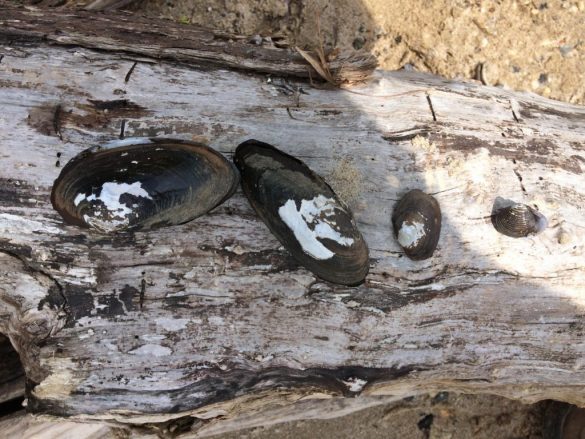
This summer, we had some exciting finds on the banks of the Delaware River along our Greenway. Riverfront North is part of the East Coast Greenway, and it’s a growing area for a variety of native flora and fauna.
These pictures show four freshwater bivalves that live offshore. The top two are native Alewife Floaters, which were believed to be locally extinct in Pennsylvania until recently. The third we believe to be a native Green Floater, which is endangered in NJ, imperiled in PA and likely extinct in DE. The bottom bivalve is a non-native clam called an “Asiatic Clam.”
Mussels are important to the ecosystem of the Delaware River along our Greenway because they act as filter feeders that “clean” the water in which they live. They do this by removing solids such as dirt, algae and other pollutants. First, they suck water in to trap the solids and then release filtered water back into the environment. Each mussel filters several gallons of water each day.
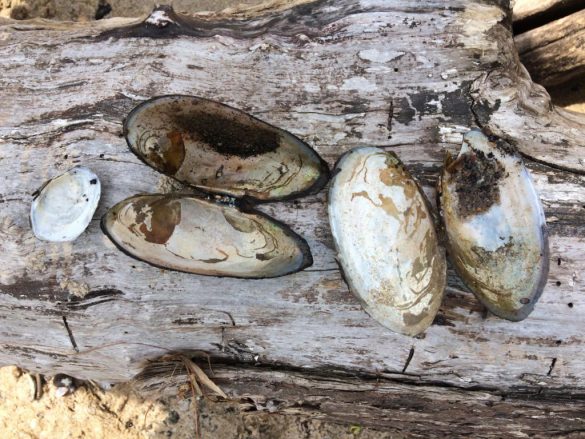
One mussel bed in Southeast PA was found to remove 26 metric tons of solids from the water in a single summer season! Our discovery of these rare mussels in our section of the Delaware River is a sign of the river’s improving health for all species. (Source: Freshwater Mussels of the Delaware Estuary: Partnership for the Delaware Estuary)
With the help of groups like The Partnership for the Delaware Estuary, Pennsylvania DEP Coastal Resources Monitoring Program, NOAA, and Fairmount Waterworks, the mussel populations are gaining more attention and leading to conservation efforts that allow the populations to begin to grow again. This means cleaner water for us all.
Nor’easter
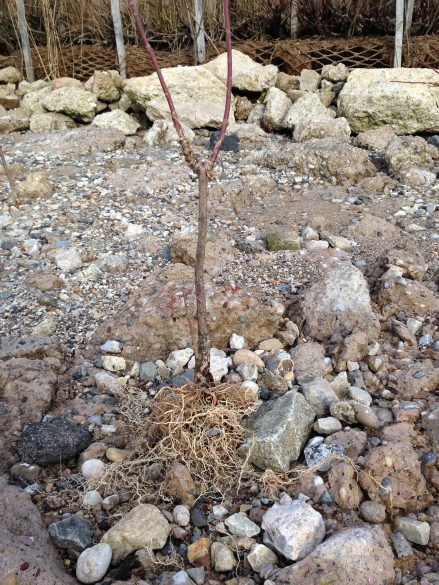
On Monday January 23, 2017, a severe Nor’easter with winds gusting to 50 mph hit Lardner’s Point Park. The winds and rain caused large waves and white caps on the river, with erosive waves hitting the shore for a significant portion of the day.
Directly south of the pier, the constant pounding resulted in the scouring of 2 to 3 inches of sand and silt. The intertidal zone is now mostly 1” to fist-sized rocks, or everything has been scoured away to a base of large broken concrete. Two (2) of the thirty-seven (37) Buttonbush shrubs planted in this area were washed away, and nineteen (19) others had about half the depth of their root balls exposed through the loss of fine sediments on the beach. Small dams of medium-sized rocks were placed on the downhill side of individual plants to encourage accretion of sediment around the exposed plants. About a dozen plants were reinstalled at a more appropriate height relative to surface grade.
In addition, there was damage t0 the toe wall. This wall was constructed of boulders and broken concrete in order to protect the toe of the coir log that was part of the live branch layering installed in this area in the spring of 2014. The toe wall is now severely compromised. Several areas were breached, with rock and boulders from the toe wall strewn downslope from the toe wall. These breaches resulted in the loss of finer stone and sediment that had been used as backfill between the toe wall and the coir log.
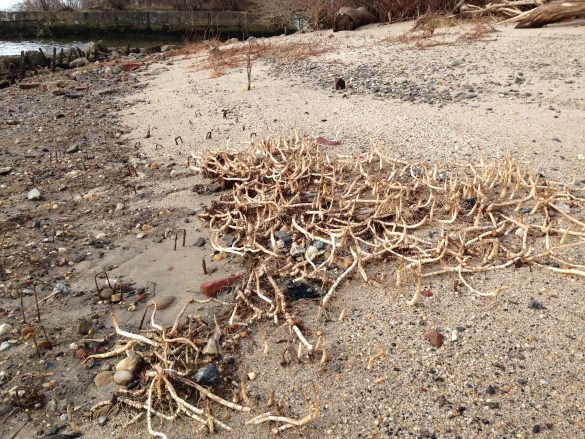
The intent of this backfill, installed in the spring of 2016, was to provide cover to the roots as they spread toward the intertidal zone, giving the stoloniferous shrub species sufficient time to develop new stem growth in front of the coir logs in the intertidal zone. There has not been any noticeable clonal spread of the shrubs, but the Nor’easter uncovered a healthy mat of roots that is now threatened by exposure to air and sun. This area of backfill has also been a fertile area for the development of seedling False Indigobush (Amorpha fruticosa), which has spread aggressively on both sides of the live branch plantings over the last 12 months, aiding in the stabilization of the shoreline.
Toe wall rebuilding and repair is scheduled with PowerCorps for Monday February 13 through Wednesday February 15, when tidal conditions are favorable for working in the intertidal zone. In the cove area south of the live branch planting south of the pier, a dune of 1-2” cobbles, 12-18” in height has formed approximately four to five feet from the toe of slope. We plan to experiment with some live staking in the protected zone between this northeast dune and the base of slope.
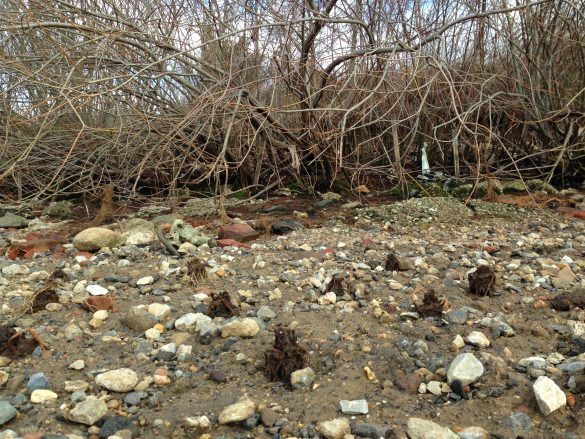
In the hybrid living shoreline at the south end of the site, although protected by a marsh toe sill, the area was still subject to the erosive forces of the Nor’easter. This was reflected in the scouring of fines from the perched beach area. In 2016, three-hundred (300) new herbaceous marsh plants, representing six (6) different species, were installed in the intertidal area, both inside the four (4) goose exclosures and outside of the goose exclosures.
Some of these species still have evergreen foliage, such as the Soft Rush (Juncus effusus), but most have senesced, with no evidence above ground of the plants presence. This followed a planting of a similar number of plants in the hybrid living shoreline marsh between 2012 and 2013.
The scouring waves from the Nor’easter removed up to 2 inches of finer sediments from the surface in the areas that were planted in 2016. This was evidenced by the exposed anchoring stakes and crowns of plants that had been installed in 2016, as well as the dominance of rubble type fill where there had previously been silt and sand. The erosion also exposed the root mass of a planting of Lizard’s Tail from the original park construction.
The silts and sand appeared to be washed down to the inlet area south of the marsh toe sill, eliminating the drop between the perched marsh area and the area at the base of the concrete wall at the south end of the site. A dune nearly 2-feet-tall has formed about 3-5 feet from the base of the concrete wall. It also appears that the dune forming in front of the base of the Willow/Dogwood thicket has increased in height.
One (1) of the three (3) Buttonbush shrubs that were planted on this area was missing, and a the root mass of a second shrub was approximately two inches above grade, due to the loss of fine materials. This shrub was replanted at the appropriate relationship to grade. The front legs of the northernmost Goose Exclosure, the only one without a concrete footing, were heaved out of the ground by the wave action. The exclosure was pounded back into the ground. No other damage to the goose exclosures was evident. Design version 3.0 seems to be holding up to some of the worst stresses in the intertidal zone.